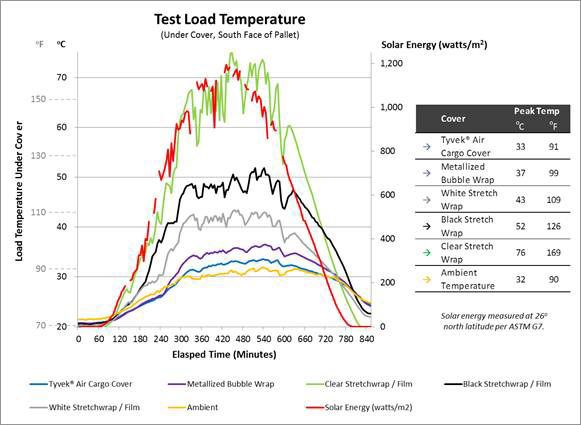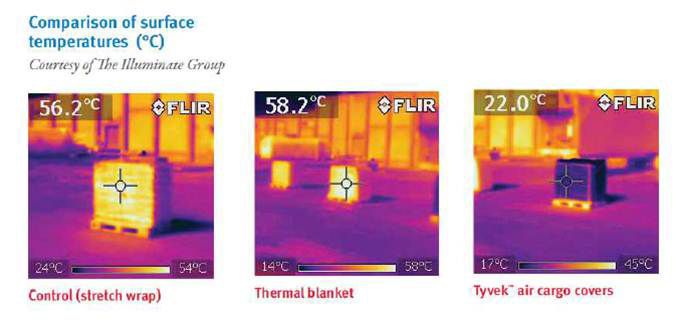Tyvek® Cargo Covers: The Science Behind the Covers
Tyvek® Cargo Covers Offer Advanced Multi-Threat Protection Against Temperature Excursions
How well are you protecting your perishable and temperature sensitive products against the hazards that threaten them?
COLD CHAIN BREAKS ON THE TARMAC – YOUR GREATEST VULNERABILITY
According to IATA research, nearly 60% of temperature excursions occur during tarmac delays. While on the tarmac, your temperature sensitive products are subject to a variety of threats that can lead to a temperature excursion including:
- Extreme ambient temperatures
- Radiation including solar radiation and emitted radiation from the tarmac itself
- Precipitation
- Heat generated by respiring perishable products that is trapped under a protective cover
How effectively does your current protection address these threats?
SOLAR RADIATION MAY BE THE BIGGEST THREAT YOU FACE
Did you know that the temperature under your pallet cover can far exceed “ambient”? Ambient temperature is measured in an enclosed and shaded device, isolated from the effects of solar radiation, wind and precipitation.
Even on a moderately hot day – when the ambient temperature reaches 32°C (90°F) – the temperature under film-based protective covers or wraps can reach 75°C or higher (167°F). These temperatures can have devastating effects on your products.
Summarized below are the results of a trial conducted in Florida, in March of 2013, demonstrating the ability of several different types of commonly used wraps and covers to protect your products from solar radiation.

Test Load Temperature
WHY REFLECTIVITY MATTERS
Solar radiation is the leading cause of high temperature spikes on the tarmac. Film based wraps and covers do not effectively protect against solar radiation.
- Clear film based wraps or covers (red trace) permit solar radiation to transmit into the load and then trap the heat, creating a greenhouse effect.
- Black film based wraps or covers (black trace) absorb solar radiation and heat up the load via conduction and emission.
- White film based wraps or covers (gray trace) more effectively reflect solar radiation, but still conduct and emit absorbed radiation into the load, resulting in inadequate protection.
- Metallized bubble wrap covers (purple trace) better reflect solar energy than the film based wraps, but are only about half as effective as Tyvek® covers at reflecting in the UV and visible spectrums, which represents the major of the energy contained in solar energy at sea level. (see graph to left)
- Tyvek® Cargo Covers (blue trace) reflect nearly all energy in the UV and visible spectrums and maintain the load temperature at 1oC above ambient temperature (yellow trace) – the only cover to effectively negate the adverse effects of solar radiation.
- Low emissivity Tyvek® covers shown above. These covers have a proprietary coating which further enhance their ability to protect your products against the threat of solar radiation, resulting in the best performance available.

ASTM Solar Spectrum at Sea Level

Comparison of surface temperatures (°C)
ARE YOU FOCUSED ON THE RIGHT ‘R’ ?
What’s most important to you? Reflectivity or ‘R’ value or both? How do you decide which covers or thermal blankets to use?
If you rely on thermal chamber testing and focus on “R-value” when selecting a thermal cover or blanket, you’re at greater risk for temperature excursions. Thermal chambers do not mimic real world tarmac exposure because they disregard the effect of solar radiation.
To effectively protect your products from temperature excursions, you need to address the three mechanisms by which heat is transferred:
- Conduction – heat transfer from a hot body/object to a colder one through direct contact
- Convection – heat transfer between a body/object and a moving fluid (including gases) at a different temperature
- Radiation – heat transfer between two bodies/objects via electromagnetic waves emitted by one body/object and absorbed by the other
as well as heat generated by the load (e.g. respiring perishable products) itself, if applicable.
How well are you protecting your temperature sensitive products against all of these threats today?
WHY THICKER DOESN’T MEAN BETTER PROTECTION
"I can’t believe how well this lightweight, thin Tyvek® cover works."
We hear that a lot.
Here’s why thicker doesn’t always mean better protection.
- In the study below, the surface temperature of pallets exposed to solar radiation protected with commonly used thermal covers and blankets is shown.
- You can see that the surface temperature of the Tyvek® cover is nearly at ambient, while the clear film stretch wrap and heavy thermal blanket had surface temperatures nearly 2.5 times as high. This absorbed energy is conducted and emitted into the load, diminishing the performance of these covers.